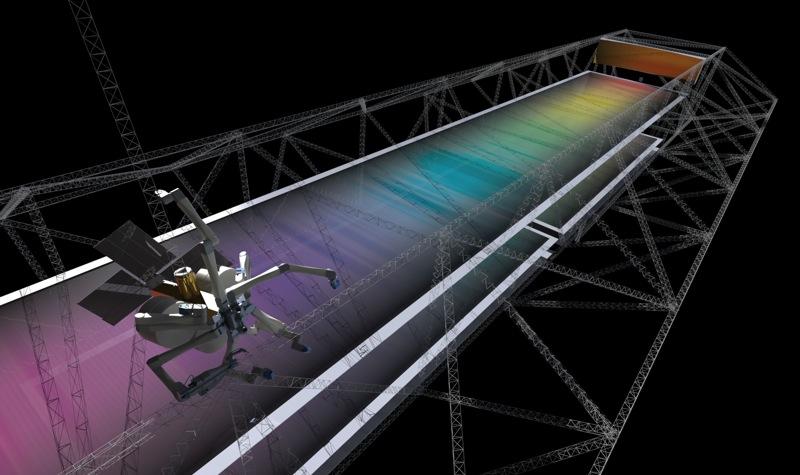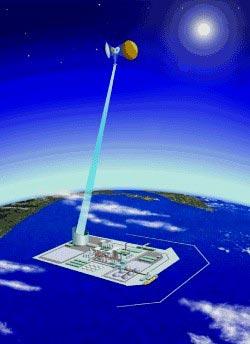 Scientists at the Japan Aerospace Exploration Agency (JAXA) say they were able to transmit 1.8 kilowatts of solar-generated power using microwaves sent to a receiver more than 180 feet from the power source, and in conjunction with 3D printing, the technology might one day be used to drive vehicles or “factories” in space.
Scientists at the Japan Aerospace Exploration Agency (JAXA) say they were able to transmit 1.8 kilowatts of solar-generated power using microwaves sent to a receiver more than 180 feet from the power source, and in conjunction with 3D printing, the technology might one day be used to drive vehicles or “factories” in space.
 During the late 1960s, Peter Glaser first described the idea in scientific journals, and Dr. David Criswell now says solar power stations could be built on the moon using 3D printing techniques to rapidly construct photovoltaic panels on the lunar surface.
During the late 1960s, Peter Glaser first described the idea in scientific journals, and Dr. David Criswell now says solar power stations could be built on the moon using 3D printing techniques to rapidly construct photovoltaic panels on the lunar surface.
The team at JAXA responsible for the successful wireless transmission of energy say that while the distances and power involved were small, the technology might easily be used to collect the abundant solar energy available in outer space. Yasuyuki Fukumuro and solar power systems researchers at the agency say the ultimate goal is to use a microwave transmitting satellite to focus energy on a radar dish of up to 1.9 miles in diameter, and they believe it can be done from an altitude of up to 22,000 miles.
“This was the first time anyone has managed to send a high output of nearly two kilowatts of electric power via microwaves to a small target, using a delicate directivity control device,” Fukumuro says.
For his part, Criswell is not surprised at the result.
“We think of beaming power…as exotic, but it has been done for at least 15 years,” says Criswell. “Power beaming is like using a big radar.”
And taking the idea one step further, Criswell says it is possible to convert common materials already on the lunar surface into engineering-grade materials like bauxite into aluminum. He says during the 1970s and 1980s, analysis of the rocks collected during the six Apollo moon landings showed those specimens contained silicon, magnesium, aluminum, and titanium, and those are the basic materials need to build functional solar cells.
“We are not talking about taking a GM factory to the moon,” says Criswell. “We are talking about machinery more on the scale of road-building equipment—roughly ten to 20 times the size of the lunar rover. The machines would move dirt around, extract metal from the soil, and produce and lay out the thin glass solar cells.”
Dr. Fernando Araujo de Castro, a principal research scientist at the National Physical Laboratory in the UK, has already done research on solar photovoltaic and organic electronics, and his work on materials and product development in the field relies heavily on 3D printing.
The cells Castro has developed, called organic photovoltaics, are built with small organic molecules which function as semiconductors when exposed to solar radiation. Those molecules can be dissolved into a solution, and then 3D printed in a variety of shapes, sizes, and colors. They may not be as efficient, but organic photovoltaics can produce approximately 50 percent of the voltage of their silicon-based counterparts, and Castro says he expects major improvement to that output very soon.
The 3D printed solar cells, made from thin and flexible material like cloth, are printed in sheets and they’re very lightweight. Auto manufactures are already testing the materials as rooftop additions to vehicles to charge batteries and power electrical systems.
Projects like the Trusselator from Tethers Unlimited, Inc. are focused on the idea that it will be possible to fabricate space system components in-orbit rather than building them on the ground. The CEO and Chief Scientist of TUI, Rob Hoyt, says his company’s analysis shows that it’s possible to gain “orders of magnitude improvement in the stored volume and mass of space systems” using 3D printing and robotic construction of components in space. TUI’s Trusselator, part of what the company calls SpiderFab architecture, would use 3D printing techniques and robotic assembly to fabricate large truss structures which are essentially football-field sized antennas. In the process, 3D printers would build carbon fiber truss structures to act as a frame for a membrane of thin film photovoltaic material.
How far do you think we are from seeing solar power transmitted wirelessly using 3D printing? Let us know in the Wireless 3D Printed Solar Energy forum thread on 3DPB.com.
Subscribe to Our Email Newsletter
Stay up-to-date on all the latest news from the 3D printing industry and receive information and offers from third party vendors.
You May Also Like
3D Printing Unpeeled: New Arkema Material for HP, Saddle and Macro MEMS
A new Arkema material for MJF is said to reduce costs per part by up to 25% and have an 85% reusability ratio. HP 3D HR PA 12 S has been...
3D Printing News Briefs, January 20, 2024: FDM, LPBF, Underwater 3D Printer, Racing, & More
We’re starting off with a process certification in today’s 3D Printing News Briefs, and then moving on to research about solute trapping, laser powder bed fusion, and then moving on...
3D Printing Webinar and Event Roundup: December 3, 2023
We’ve got plenty of events and webinars coming up for you this week! Quickparts is having a Manufacturing Roadshow, America Makes is holding a Member Town Hall, Stratafest makes two...
Formnext 2023 Day Three: Slam Dunk
I’m high—high on trade show. I’ve met numerous new faces and reconnected with old friends, creating an absolutely wonderful atmosphere. The excitement is palpable over several emerging developments. The high...































